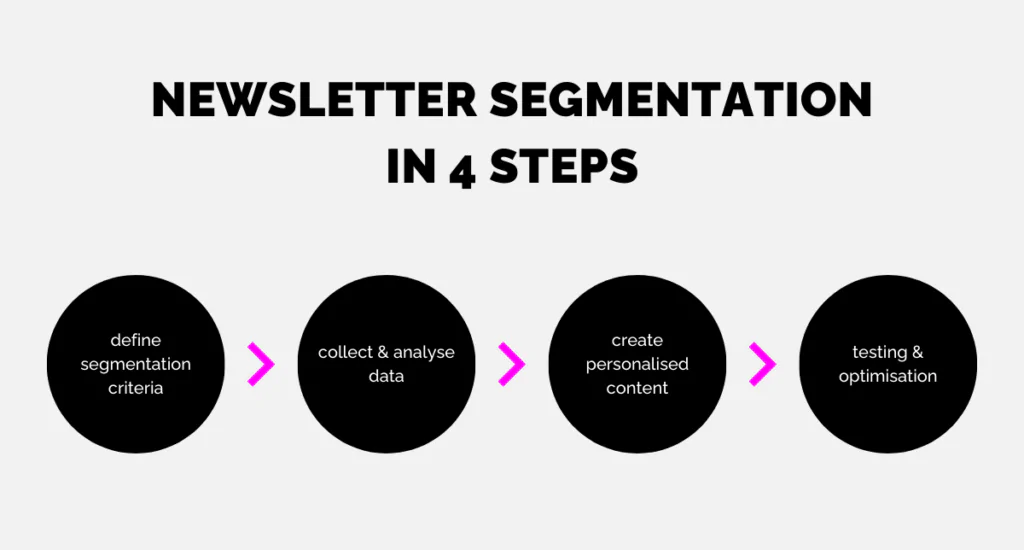Segmentation and personalisation are two key concepts used in newsletter marketing to improve the relevance and effectiveness of campaigns. In email marketing, segmentation and personalisation are not an optional extra, but a must. The reason for this is obvious: they lead to measurable success. This statement is not based on mere assertions, but is supported by concrete data:
- A study conducted by McKinsey in 2021 shows that 71 per cent of consumers expect personalised approaches from brands and companies. In addition, 76 per cent of consumers feel frustrated when communication is not tailored to them.
- According to a survey by Yieldify, 75 per cent of consumers prefer to buy from brands that offer customised digital experiences.
- Salesforce reports that 97 percent of marketers see an increase in sales when they personalise their marketing strategies.
Even beyond these impressive figures, we experience it in everyday life: personalised communication creates a connection, while generic messages often come across as distant and cold. We enjoy receiving offers that are tailored precisely to our needs and preferences and that arrive at the perfect moment. After all, this is the core idea of inbound marketing.
What is segmentation?
Segmentation in email marketing is a process where you divide your subscribers into smaller, homogenous groups based on certain criteria. This grouping allows marketers to send more targeted and relevant content that is tailored to the specific needs and interests of each recipient group. By using segmentation, companies can increase the effectiveness of their newsletter campaigns, boost engagement rates and ultimately achieve greater customer loyalty.
Segmentation criteria
Various criteria can be used to carry out effective segmentation. These criteria help to group the newsletter recipients in such a way that the communication can be made as relevant and personalised as possible.
- Demographic data: Demographic segmentation involves categorising newsletter subscribers based on demographic characteristics such as age, gender, location, education level or occupation. This type of segmentation is particularly useful for personalising content based on the circumstances or needs of specific age groups or genders.
- Interests: Segmentation by interests allows you to divide your target audience based on their preferences, interests or affinity for certain topics, products or services. This information can be obtained from users’ self-reported interests or from their interaction behaviour with previous newsletters.
- Behaviour: Behaviour-based segmentation uses recipients’ previous engagement and interactions with your brand. This includes aspects such as purchase history, frequency and type of website visits, click behaviour in previous newsletters or participation in events and webinars. By analysing these behaviours, you can identify patterns and adapt your communication accordingly to make it more relevant and appealing.
What is personalisation?
Personalisation in the context of email marketing goes beyond simply addressing the recipient by name. It refers to the fine-tuning of every aspect of the newsletter. The aim is to make it as relevant and appealing as possible for the individual recipient. By personalising newsletters, subscribers feel directly addressed and valued, which not only increases the likelihood that they will open and read the newsletter, but also increases engagement and conversions.
Options for personalisation in newsletters
- Salutation by name: The simplest and most well-known form of personalisation is to address the recipient by name. This can have a positive effect on the perception of the newsletter, as it conveys a basic level of recognition and individual approach
- Display of relevant products or services: Another method of personalisation is the insertion of products, services or content based on the recipient’s individual preferences or previous behaviour. For example, if a subscriber has recently searched for sporting goods on your website, the newsletter could highlight special offers on this topic.
- Dynamic content: Dynamic content are elements of a newsletter that can change depending on the recipient. This can be based on various factors, such as the recipient’s location, the weather in their region or their interaction history with previous newsletters. By using dynamic content, each newsletter can be customised to the recipient, which significantly increases relevance and engagement.
- Statements tailored to specific characteristics of the recipient: Deep personalisation can also be achieved through statements or offers based on specific characteristics or needs of the recipient. For example, if you know that a segment of your subscribers is interested in environmentally sustainable products, you can present these recipients with specific content or offers that reflect this interest.
Personalisation is crucial in newsletter marketing. It strengthens the connection with subscribers and increases campaign effectiveness. You customise content to the needs and interests of recipients. As a result, companies increase the relevance of their messages. At the same time, they improve engagement rates and customer loyalty. Conversion rates also benefit. In view of the daily flood of emails, well thought-out personalisation is crucial. It can make the decisive difference in the competition for attention.
Benefits of segmentation and personalisation
Implementing segmentation and personalisation in email campaigns offers a number of significant benefits. These have a direct impact on the success of marketing efforts.
- Higher open rates: By tailoring subject lines and content to the specific interests and needs of recipients, newsletters become more relevant and engaging. As a result, recipients are more inclined to open the emails.
- More clicks: Personalised content and call-to-actions specifically tailored to recipients increase the likelihood that users will click on links. This increases interaction with the newsletter and leads users directly to the website or to specific offers.
- Better conversion rates: Targeted offers and content tailored to the individual recipient increase the likelihood that they will carry out the desired action (e.g. purchase, registration).
- Lower unsubscribe rates: If users regularly receive content that is relevant and interesting to them, they are less likely to unsubscribe from the newsletter.
- Improved customer experience: Segmentation and personalisation make recipients feel understood and valued. This contributes to a positive customer experience and promotes customer loyalty.
- Higher ROI: The targeted approach and relevant content lead to more effective marketing campaigns. This results in a higher return on investment, as marketing resources are utilised more efficiently and deliver better results.
Strategies for successful segmentation and personalisation of newsletters

Define segmentation criteria: Before segmentation, it is crucial to establish clear criteria based on your marketing objectives and knowledge of your target audience. Consider which characteristics or behaviours differentiate your customers. Possible criteria include demographic data, behavioural patterns or individual preferences. A precise definition of these criteria is essential for targeted and effective messages.
Collect and analyse data: Use every interaction with your customers to collect valuable data. This can range from simple demographic information to complex behavioural patterns.
Create segments: Based on the data you collect, you can divide your subscriber list into relevant segments. The more specific the segments, the more targeted you can make your content.
Develop personalised content: Create content that is tailored to the needs and interests of each segment. Use personalised recommendations, offers or information to maximise the value for your subscribers.
Test and optimise: Use A/B testing to test different segmentation and personalisation strategies. Analyse the results to continuously improve your approaches.
Conclusion
Segmentation and personalisation are two important factors in improving the success of newsletter marketing. By using segmentation and personalisation, companies can not only optimise the immediate performance of their email marketing campaigns, but also build valuable long-term relationships with their customers.
These strategies enable the delivery of content that truly resonates and meets the individual needs of recipients. This improves the overall brand experience. They also help to reduce the inundation of customers with irrelevant messages, which has a positive impact on brand perception. At a time when consumer attention is becoming increasingly valuable, segmentation and personalisation are essential tools to stand out in the flood of marketing messages and offer real value. Ultimately, these customised strategies not only lead to an increase in short-term sales figures. They also promote customer loyalty and trust in the long term.



